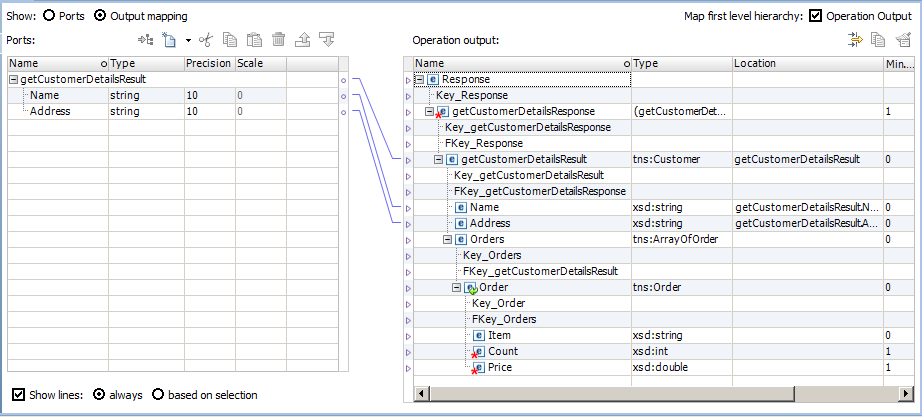Transformation User Interface
The web services Output transformation, the Fault transformation, and the Web Service Consumer transformation contain a user interface that you use to configure the SOAP message.
To configure a transformation to generate a SOAP message, create input ports in a structure similar to the SOAP message hierarchy. The WSDL or schema determines the structure of the hierarchy. Map each input port to a node in the SOAP message.
The following figure shows a mapping between the input ports and the SOAP message nodes in a web service Output transformation:
Input Ports Area
Create groups of input ports in the Input Ports area. Include input ports for each level in the SOAP message hierarchy that you need to map.
You must create a Response or Request input group and the child groups that receive the data.
When you create input port groups, define a primary key in each parent group. Define a foreign key in each child group. The foreign key relates the group to a parent group.
You do not have to define keys for the Response level or the WSDL root level unless you are passing data at the WSDL root level. For example, the root level might contain HTTP headers.
You might create groups of ports similar to the following groups for customers and orders:
Response
Response_Key
Customer_Details_Root
Key_Cust_Det
FK_Response_Key
Customer
Customer_ID
FK_Cust_Det
Name
Address
Orders
Order_Num
FK_Cust_ID
Order_Items
Order_Num
Item
Count
Price
Operation Area
The Operation area shows the elements in the SOAP message hierarchy as defined by the WSDL or schema. The SOAP message does not have to contain all the elements from the WSDL or schema. The message contains the data that you map from the input ports.
Multiple-occurring nodes and complex nodes define hierarchy levels in the SOAP message structure. The Developer tool adds keys to the levels to create parent-child relationships between them. All levels in the hierarchy, except for the leaf levels, have a primary key. Each child level has a foreign key to a parent level. The keys that appear in the SOAP message hierarchy do not appear in a SOAP message instance. The Data Integration Service requires values in the keys to relate levels of the data when it generates the SOAP message.
The Location column contains the group name and input port that contains the data for an element in the SOAP message. The Location column is empty until you map an input port to the node.
In the preceding figure, the SOAP message contains a single instance of customer details and orders. The Orders group contains a multiple-occurring element called Order. The SOAP message hierarchy has the following levels related by key:
Response
GetCustomerDetailsResponse
GetCustomerDetailsResult
Orders
Order
The Response level represents the root of the response message. The Data Integration Service requires this level to attach headers to the SOAP message.
The GetCustomerDetailsResponse level is the root of the message.

